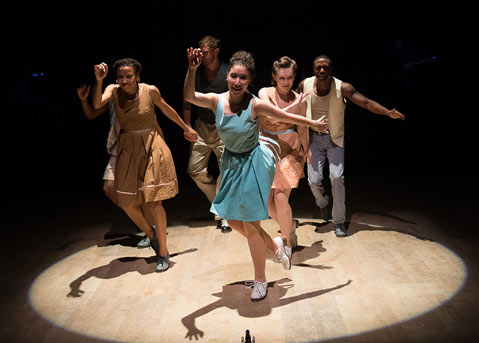The Blues Project at the Granada Theatre
Dorrance Dance with Toshi Reagon and BIGLovely Perform

An alternately fierce, simmering, and joyful interplay between musicians and dancers, last Saturday night’s performance The Blues Project offered an exciting collaboration between the New York–based tap group Dorrance Dance and musical group Toshi Reagon and BIGLovely. Equal parts live concert and dance performance, the musicians (playing electric guitar, bass, violin, and percussion, with Reagon on acoustic guitar and vocals), sat on an elevated platform upstage, while the 10 genre-defying dancers commanded the space downstage.
Stripped of any sets, the Granada stage was bare; shifting colors of light were projected onto the back wall — gray, turquoise, soft lavender, and red — evoking a feeling of being under a vast sky as afternoon turns to dusk. The bare stage and unassuming costumes (casual black for the musicians, muted 1950s-inspired dresses and pant/vest combinations for the dancers) drew attention to the performers onstage, whose instruments and bodies created their own visual and sonic landscape.
The Blues Project might best be described as a rhythmic flurry of energy: bound or explosive, coy or confident. Sliding, scraping, and percussively attacking, dancers produced music in tandem with the band, generating a call and response between bodies, voices, and instruments. The dancers did not move to the music, but rather physically embodied and manifested the music, adding new depth to the sonic whole. Together, musicians and dancers generated a lively conversation between bodies, with each voice (danced, played, or sung) ringing clear.
Indeed, one of the most wonderful aspects of The Blues Project was its showcasing of individual artistry. Unlike a corps de ballet, whose members must move together in perfect symmetry, each Dorrance dancer was uniquely expressive, exuding a personal style even while performing in unison. A series of solos — including a rivalry between two women — further emphasized the importance of the individual and added a true sense of vitality. While foregoing perfect unison, each dancer nevertheless maintained a quality of impressive precision and control, articulating multiple syncopated rhythms with the minutest movements of his or her feet.
Fusing tap with other various performance genres — soft-shoe Charleston, gymnastic inversions, European modern dance, African-influenced movements and aesthetics — the performance highlighted a versatile, fluid style that made use of the entire body, including a mobility and sharp expression through the upper torso and limbs not always seen in tap dance. The symbiotic relationship between music and dance produced a fast-paced, jubilant evening of energetic musicality and physical expression. With roots in tap, which, according to their website, is “America’s most long-standing indigenous jazz vernacular,” Dorrance Dance forges a new space between contemporary styles and traditional forms, resulting in a virtuosic performance, translating to audiences an energetic, rhythmic euphoria of sound and sight.



